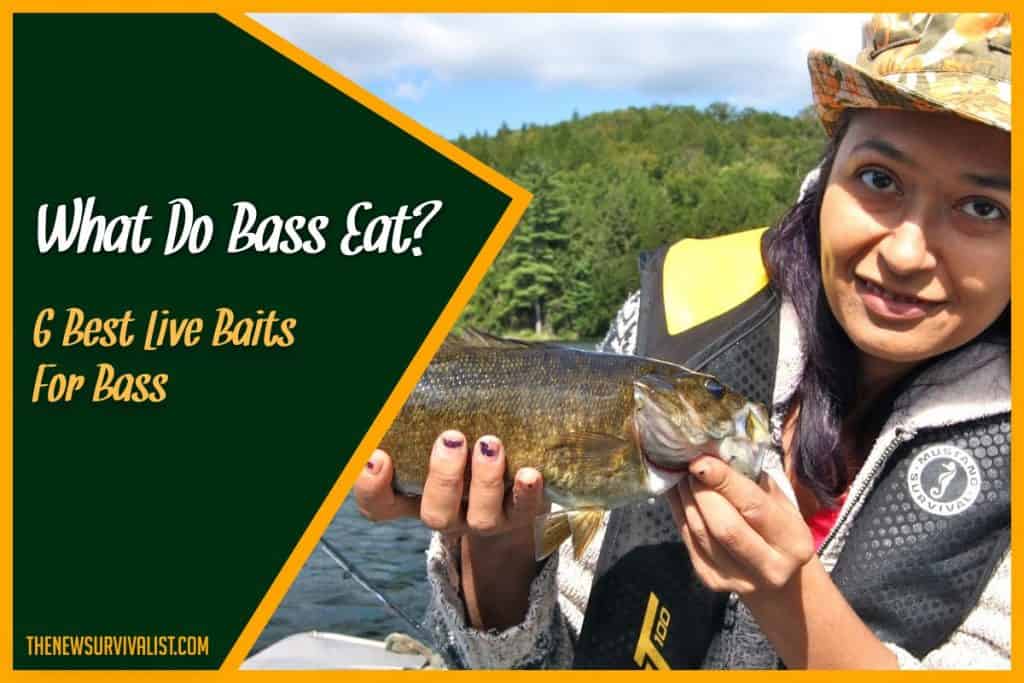Bass are popular game fish among anglers, putting up a great fight on the line. They also taste amazing when cooked right. Moreover, they’re one of the most common fish people encounter in the lower 48 states – with most members of the species living in freshwater conditions.
What do bass eat? Live bait needs to appeal to the senses bass use to hunt, which means visibility, scent, and movement are crucial considerations. You need to understand how bass live to hook them down the line. We’d strongly recommend using minnows, bluegills, crawfish, worms, leeches, and salamanders for this, as each offer their own distinct advantages.
No matter the bait of choice, you want to keep them alive and comfortable for as long as possible. Mind their oxygen, feed them properly, and don’t overcrowd their storage.
Even the best bait needs the right situation to thrive. Knowing about the different types of bass and how they live provides you with a ton of useful information alongside good opportunities to put them to use.
Bass Behavior In The Wild
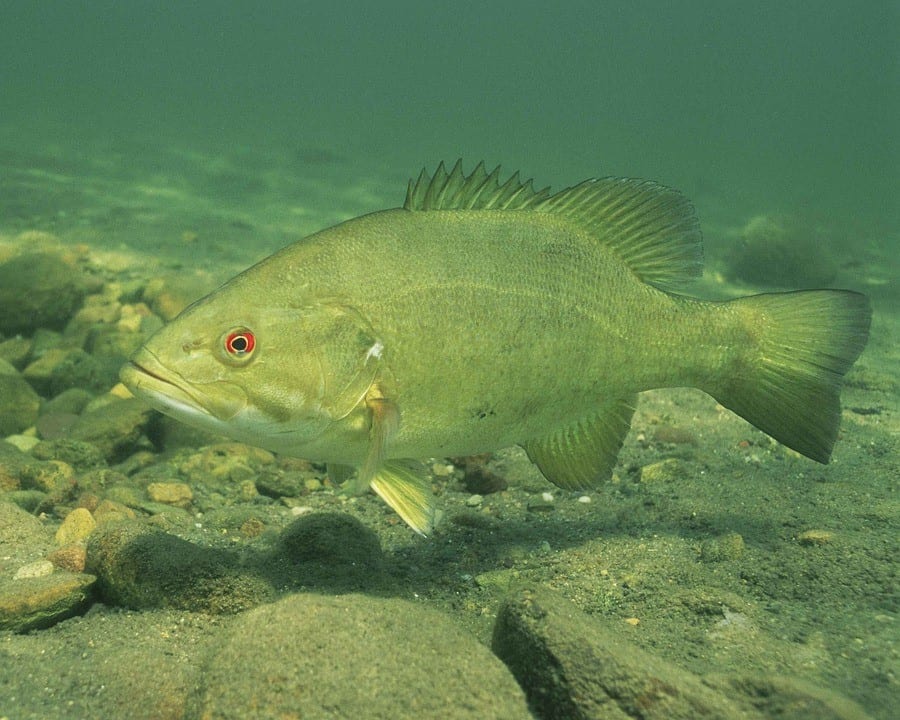
Bass are fast, powerful fish with superb acceleration. They’re excellent at short chases, and cruise around in modest groups scientists call aggregations. They stick near cover, which are local structures in water that allow them to hide – either to pounce on prey or avoid predators. Bass rarely ambush, preferring to make use of tactics such as flushing and trapping.
Flushing involves startling groups of prey, pouncing on fish that mistakenly darted towards them. Trapping is done in chase, forcing their prey all the way to the water’s shallows to restrict a whole plane of movement from their escape. Prey is usually swallowed whole – often headfirst.
Bass are primarily drawn in by vibrations in the water. Scent and chemical releases are perceived a bit slower, but make them more likely to commit and get hooked. Their visibility is quite limited, especially in deeper waters, near cover, or at night.
Why Is This Important?
The difference between ambush and chase is huge, but most people assume bass do both in equal measure. The main takeaway from this information is that bass well within cover are likely at rest, hiding from their own potential predators. Bass at rest won’t feed even if you land some nice, juicy bait inches from their mouths. You can’t just cast in cover and hope for the best – play it smart.
Instead, try to exploit their feeding habits. Bass respond promptly to rapid movements in the water, which means you’re safe to cast multiple times: it might actually entice them more. In fact, bass occasionally go for prey even after they’ve recently fed. Energetic, fast-moving bait can literally annoy bass into eating them, which works well in your favor.
Cover for them is cover for prey, so you’re unlikely to find bass hunting right in the thick of it. Try to cast near cover or foliage, as this is their preferred hunting and spawning grounds.
Make sure you cast as close as possible to bass aggregations, as their vision underwater is atrocious. Live bait works best if it’s thrashing aggressively, triggering instinctual hunting behavior in bass. That doesn’t necessarily mean bass will commit at this point – this is where scent and chemical releases play a decisive role in enticing them to your hook.
How Does Bass Size Factor In?
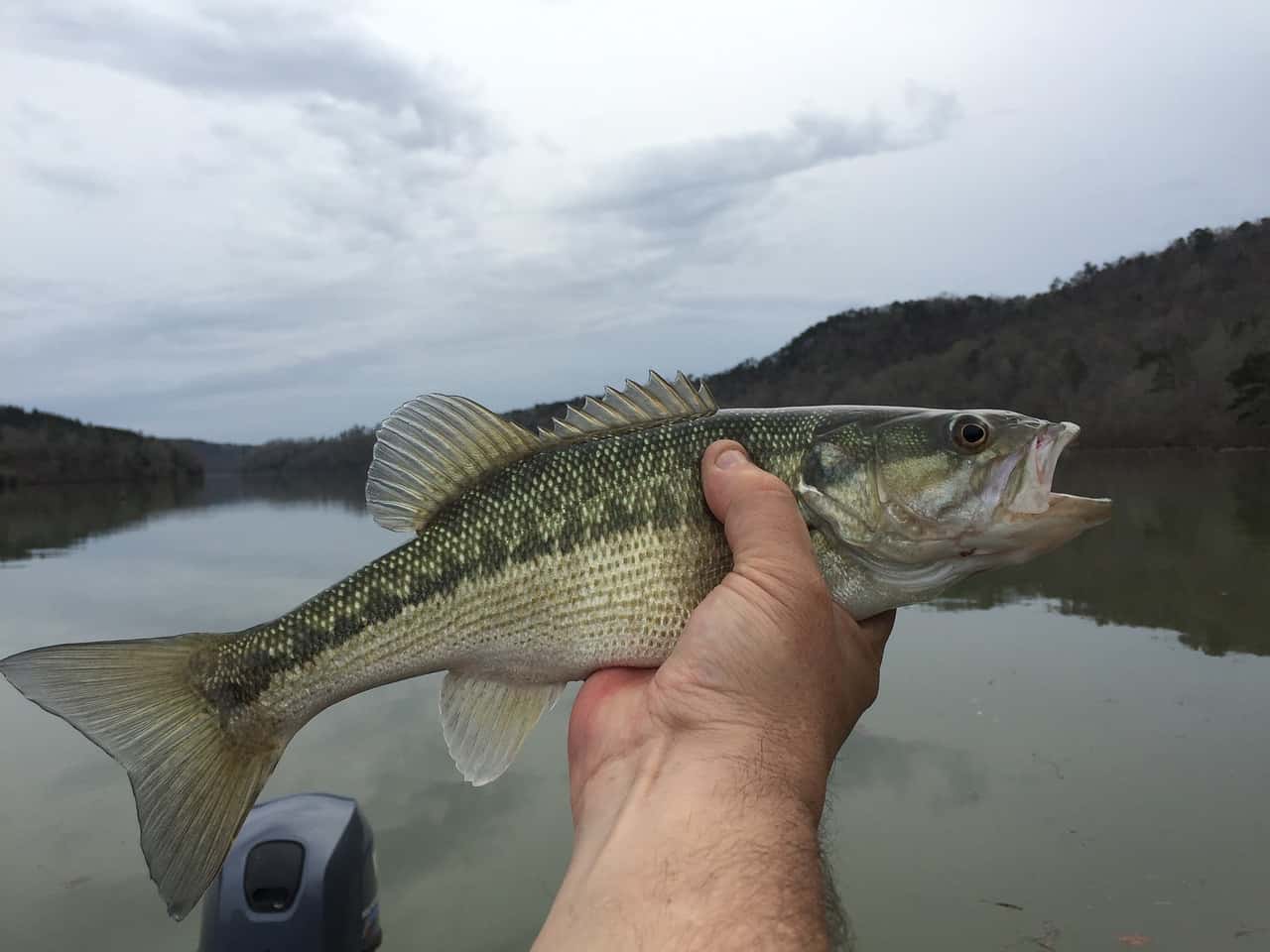
Bass fall between a huge size range. The freshest of spawns measure barely over a tenth of an inch (3mm) at birth, and most specimens can grow up to 20 inches (508mm) in length. Because they only swallow prey whole, a bass’ size actually determines their diets.
Younger, smaller bass feed on insects and tadpoles at the onset of their lives – safe, digestible prey. They’ll gradually work their way up, beginning to feed on minnows and other small fish. Bass usually do away with them over time due to their lacking nutritional value.
Developed bass forage on minnows, bluegills, and even other bass. At this point, they’re large and powerful enough to consume strong, hard-to-digest prey like crawfish. They’ll hit this mark at the 3-4lbs (1.4-1.8kg) range.
Keep your live bait small and easy to consume if you’re going for younger bass. Worms, minnows, and leeches thrive here, being high in protein, less dangerous, and all-around accessible. If you happen to be eyeing older bass, crawfish, bluegill, and salamanders work best. Smaller bass steer clear of those two in favor of easier meals.
Does Bass Species Matter (That Much)?
There are 9 distinct species of bass recognized in the States, with many more across the world. They generally operate with similar behavioral principles, though each species requires a bit of nuance and familiarity to draw them in specifically.
It can be very intimidating for newcomers, so ease your way in with something simple. The differences between smallmouth and largemouth bass make for a great starting point. The fishing, catching, and even dining experiences differ greatly between these two.
Smallmouth vs Largemouth
There will be occasions where both smallmouths and largemouths dwell in the same body of water. Keep their behavioral differences in mind when casting. You’ll eventually be able to draw in and catch the type you’d prefer. It just takes a bit of luck and a lot of practice.
Smallmouths are lean and energetic, flitting around in open waters or strong currents. Aim for these spots to increase your likelihood of snagging a smallmouth bass. They’re also a bit smaller than largemouth bass, but put up a better fight for their weight. Smallmouths are generally quite active hunting down prey, so you can afford to cast a bit further from cover with them.
Largemouths are a tad lazier, sticking near cozy cover. Do remember that largemouths rarely enter the cover itself – even then, it’s usually done to hide from predators rather than feed. They usually lurk near the edge, patiently waiting for prey to wander close.
This also works well because largemouths bed around similar areas, ending with them spawning new young. The process starves and tires them out, which makes bait nearby look all the more tempting. Even smallmouth bass stick near cover when spawning. Bass mostly spawn in spring, so casting near cover during this season could net you either species of bass.
For bass in general, it’s best to land your lines as close to their location as possible. Common techniques to do so include flipping and pitching, though accuracy could take some time to improve. Once you’ve got a handle on the technique, aim to cast near deep foliage or hard cover. Resting bass deep in cover usually won’t bother with feeding altogether, wasting your time.
Another important thing to remember is that smallmouths have slightly better vision than largemouths. They’ll catch on if you use thicker fishing lines, especially during the day. Enough light reflects off to create a clear distinction even in the water’s depths. It’s less of a problem at night, but we’d recommend you stick to using thinner lines in general.
Smallmouth and largemouth bass do have similar diets. Past the 4lbs (1.8kg) mark, both can feed on the same wide range of live bait. We’ll move on to some great recommendations for most species of bass, along with what advantages each type of bait has to offer.
What Do Bass Eat?
1. Minnows
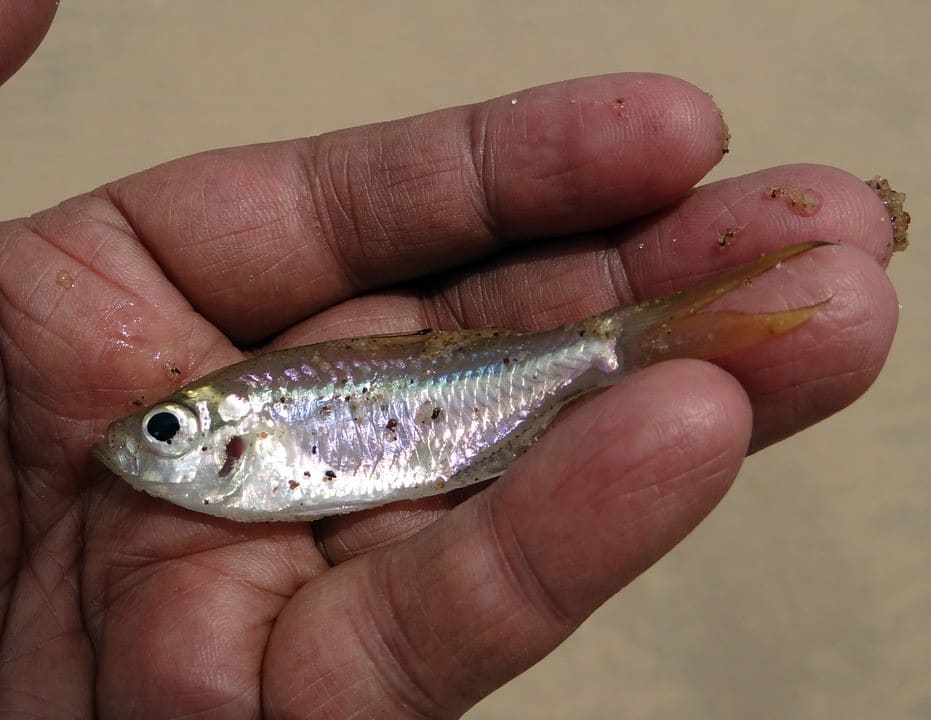
Minnows are already a staple in their diets, making for a very attractive food source for bass. They particularly excel at drawing in smaller specimens. This might be preferred in some cases. Younger bass boast softer meat and fewer toxins accumulated in their bodies.
Minnows are particularly effective at drawing in white or striped bass, though they’re generally very competitive bait even among other bass species. Minnows are a great live bait to use, but they do come with a few important drawbacks – especially regarding maintenance needs. You’ll end up developing good live bait handling habits with minnows, so it isn’t a complete loss.
Minnows are fragile, and that can’t be overstated. You can even kill them by casting too hard, which is a negligible risk with other live bait. Mismatches in temperature, oxygen, or pH levels will do them in quickly. They make for amazing bait, but getting to that point can be challenging for inexperienced live bait handlers.
Mind their storage tanks. Feed them to bolster their energy – goldfish pellets are great for this. A bubbler is a necessity for minnows, providing them with ample oxygen to survive. Try to match your bait bucket’s temperature to your fishing area as closely as possible.
Finally, make sure the minnows you have are suited for your fishing area. Minnows can come from freshwater, brackish, and saltwater environments. Saltwater minnows in freshwater lakes will rapidly bloat from osmosis, killing them in a matter of minutes. Other mismatches will lead to similar results. Couple that with hook stress and general fragility and you might get very little use from your minnow live bait.
2. Bluegills
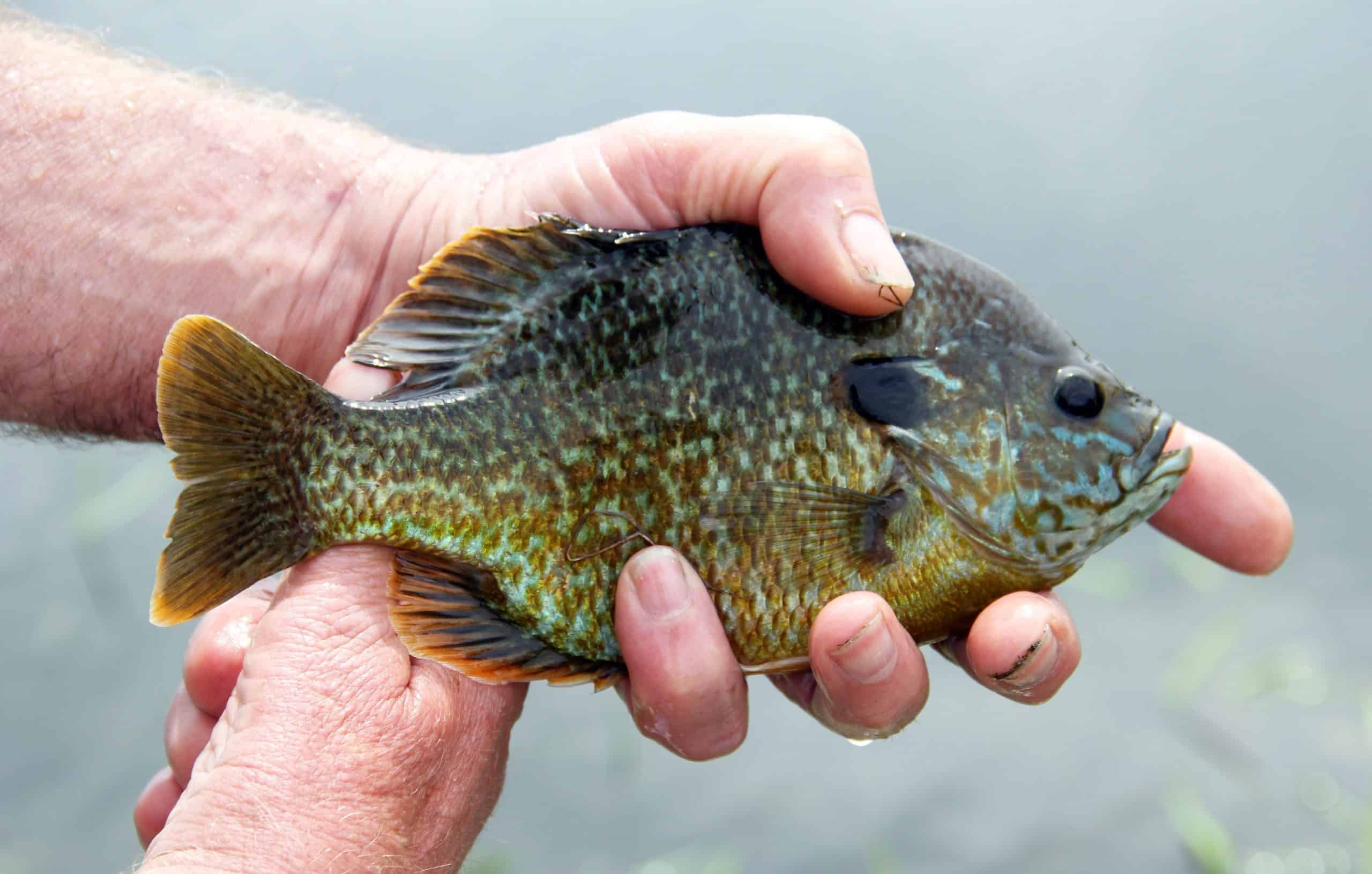
Bluegills are amazing bait, and this is due to their distinct smell underwater. Most species of bass fine bluegills irresistible! They also tend to attract larger specimens of bass. In fact, the biggest bass caught (22lbs/9.9kg) was fished using a live bluegill.
Try to keep your bluegills under 5 inches long. Past that point even large bass struggle to swallow them whole. This puts most off from even trying, extending the delay between bites.
Keep your bluegills healthy and lively. Energetic prey draw in bass, while dead or dying bait attracts other species like catfish. They aren’t as fragile as minnows, but some care still needs to be taken. Keep them in an area with clean water, decent food, and plentiful oxygen.
Bluegills are sometimes illegal to use as live bait, depending on the state. Always bear your local area’s legislation in mind – you could end up with hefty fines or even jail stints otherwise. It’s usually okay to use wild bluegill caught as live bait, provided you use them in the same body of water they were fished from.
3. Crawfish
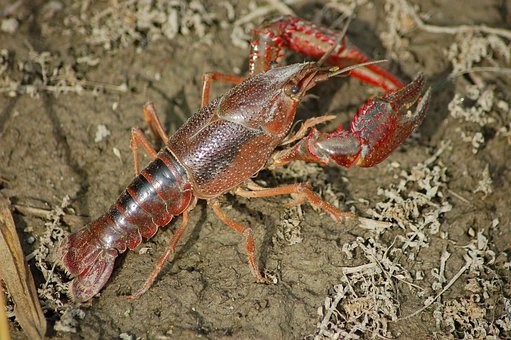
Crawfish are more of a niche treat, but bass love them! They’re especially great to use after spawning season, as most bass won’t have fed for at least 10 whole days. Crawfish are nutritious, high-protein, and deliciously fatty – perfect for starving bass!
Their claws and tough shell help keep smaller bass away, improving the odds of you getting a larger haul for your efforts. Bass actually swallow crawfish tail-first, as their sharp claws would prove a danger otherwise. You could declaw them to make them more enticing to bass, but that runs the risk of your live bait dying prematurely. This is very likely to happen when you’re inexperienced, and we’d personally recommend not bothering with the hassle.
Softshell crawfish are also more effective bait than hardshell ones. The terms softshell and hardshell correspond to crawfish development stages, rather than different species. Softshells are crawfish in the process of growing their new shells. They can be up to 92% edible meat. Softshells pose less risk and are much easier for bass to digest, making them better as live bait.
Lastly, crawfish are pretty hardy specimens. They don’t need sensitive filtration systems or bubblers to supply them with oxygen and can last for weeks in storage with minimal fuss. All they need to live decently are breathing holes, food, and enough water to cover their bodies. Lettuce makes good bait feed for them, on top of providing minimal water pollution risk.
4. Worms
Worms are very appealing live bait, and unlike most options, you can comfortably cultivate them outside of aquatic environments. You can readily farm worms to not only meet your fishing needs but even put them to work providing compost for your prepper garden. If you’re farming large quantities of worms, you might even turn a profit from your efforts.
They have very recognizable scents – certain top-feeders can even make out their odor before the worms break the water’s surface. Worms begin to suffocate in water but can last for days before drowning. This suffocation provokes a thrashing response, and the movement draws in fish.
They’re popular meals for bass owing to their high protein content, lack of bony protrusions, and how easy they are to swallow. Bass are also aggressive and might go for bait even if they’re full. The movement alone might annoy them enough to pounce, netting you a clean catch.
They’re also the only live bait on the list that can’t tuck into crawlspaces underwater. This is because they’re incapable of swimming, so you won’t have to worry about your line getting snagged on any underwater structures.
5. Leeches
When the minnow and bluegill population begin to dry up, leeches tend to be the next prey species in line for hungry, foraging bass. Some anglers aren’t fans of using leeches for bait. It can usually be chalked up to their inexperience, fear, or disgust at handling them. Leeches aren’t bad to use, though how well they perform is a bit dependent on the season.
Leeches are sorely underrated live bait and are a particular treat for smallmouth bass. Ribbon leeches are the best species to use for fishing, though it might work a bit too well – other fish you weren’t looking for could be drawn in by their alluring odor. Horse leeches are the exact opposite, so steer clear of these green timewasters.
They mate during the spring, with the adults of their species dying after secreting cocoons full of young. Leeches are popular with bass during the start of summer, but this tapers off over time due to mounting scarcity from both predation and fatal reproduction on their part.
Think of it like meeting seasonal demand – bass fond of their taste are more likely to go for your leeches. With some cleverness and luck, you’ll be bringing in a decent haul of bass in no time.
Leeches are also very easy to store long-term. They can last for months without feeding, though feeding them once a month is strongly advised. You can feed them insects or worms to keep their energy topped off. Accumulated detritus and waste are the biggest risks you need to deal with from leeches. Replace their water every other day to control that concern.
6. Salamanders
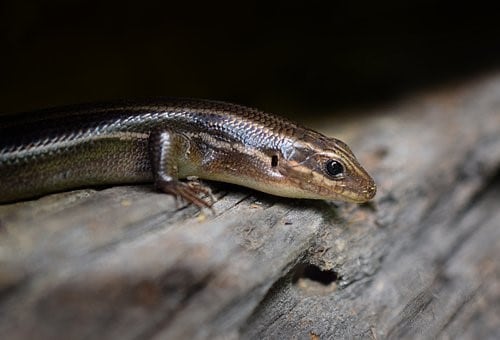
Salamanders are one of the most underrated live baits to use for fishing. Also known as waterdogs, these amphibians are huge pests for bass. They can grow quite large, easily clearing half a foot in length early in development.
It’s not that they taste or smell especially good – most bait on this list offer one or the other. What draws bass in is the salamander’s reputation for destruction. They’re notorious for decimating bass spawning beds along with the eggs resting within, making them high-priority targets for bass.
Bass will attack them even if they’d recently fed, and will do so urgently. They hate salamanders enough to kill them before feeding, crushing them with their strong pharyngeal teeth. You’ll need patience when using salamanders as live bait, giving slack to your line as needed. It might take a while for salamanders, but your composure will be rewarded.
Their effectiveness comes at a cost. Many species of salamander are illegal to use as live bait, and what makes up that list will vary across state lines. You’ll also be restricted to larval salamanders. Older specimens lose their gills along with their value as live bait. Use them before they mature, and always be mindful of local legislation.
Salamanders need constant moisture, so keep them in an enclosure with sufficient water. Try not to touch them too much, as the oil and sweat from our bodies will compromise their health. You’ll need to feed them every other day – brine shrimp and worms are decent feed for them.
Best Ways To Handle Live Bait
Meet your bait’s living conditions as well as possible. What that entails depends on your bait of choice, but you want them to be active on the line. This means minimizing the damage and stress they’d accumulate in captivity. A decent quality of living for them means better results when fishing, so it’s in your best interest to keep your bait comfortable.
Mind their water conditions as well, as certain species of live bait won’t match your fishing area. This leaves them with a lower tolerance to their new environment, and they’ll likely die in a matter of minutes. This is usually long enough for you to catch something worthwhile, but it’s always best to ensure your bait suits the location beforehand.
Finally, tug at the line from time to time. Bass are drawn to rapid movement, but doing this also serves a proactive purpose. Most live bait will scurry around for nooks to hide in, making them challenging for bass to reach. At certain angles you might not even be able to dislodge your bait, forcing you to cut the line and pollute the environment.
Final Thoughts
Live bait is very good for catching bass, but what you need to understand most is how to present it. Figure out what senses you need to entice – learning how bass operate provides you with all the information needed to achieve just that. Use the live bait best suited for your needs, and it’s unlikely you’ll ever leave fishing trips empty-handed again.

